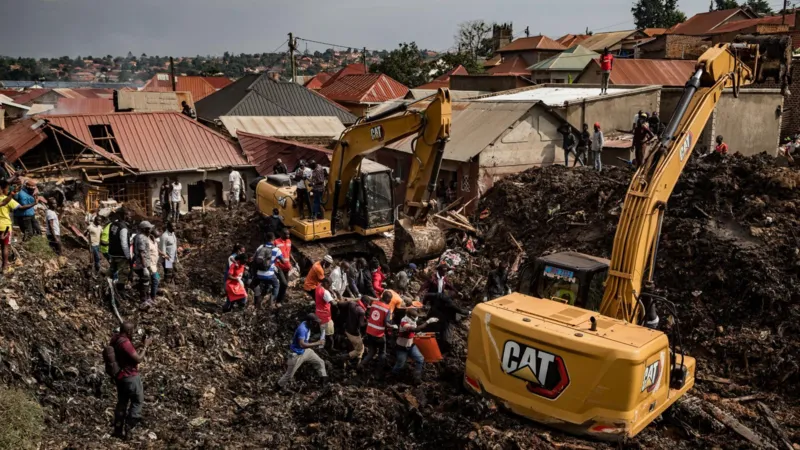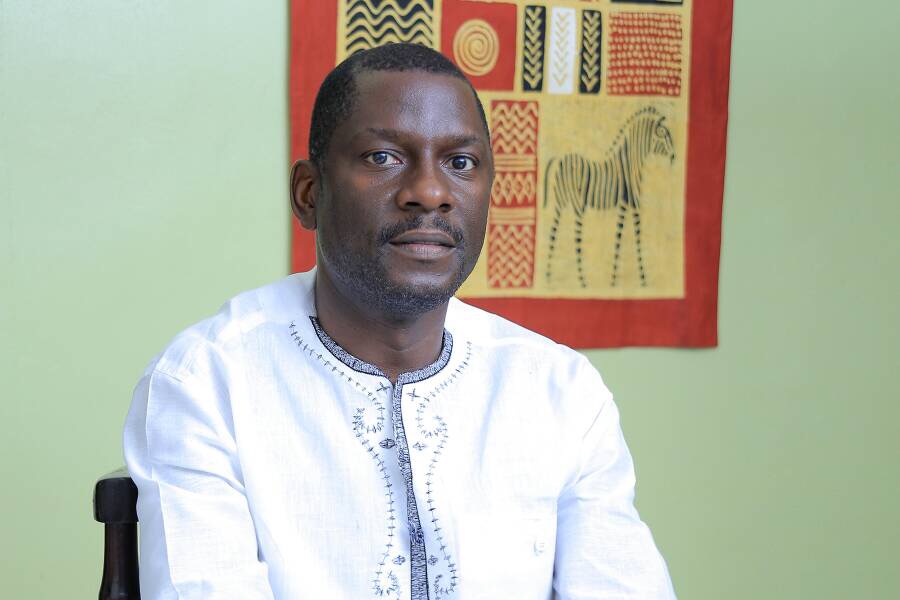Kampala, Uganda — Early warnings of a potential collapse of the Kiteezi landfill in the capital Kampala might have been ignored by policymakers, leading to the fatal disaster that has left 23 people dead and scores displaced.
Researchers at the universities of Makerere and Cape Town warned in 2015 about the stability of the Mpererwe Landfill- Kiteezi. They made recommendations in a study that this news site has retrieved.
At least 23 people are now known to have died after a landslide at the massive rubbish dump in Kiteezi, northeast of Kampala, happened on August 10, following weeks of torrential rains.
Rescuers are continuing to dig through the waste in the hope of finding more survivors after the landslide and President Yoweri Museveni has ordered a probe and punishment of culprits for possible criminal negligence.
The 36-acre (14-hectare) Kiteezi landfill is the only one serving the whole of Kampala, a city home to an estimated four million people. The city authorities have been trying to find a new site for many years.
In a study titled Study of Slope Stability and Settlement Characteristics of Mpererwe Landfill, researchers – Bernard Wasswa, Dickens Kakitahi, Samuel Jjuuko and James Semuwemba from the Department of Civil Engineering, Makerere University, and Denis Kalumba from the Department of Civil Engineering, University of Cape Town, South Africa, unveiled critical insights into the stability and settlement characteristics of the Mpererwe Landfill.
The study spotlighted the potential risks associated with the landfill’s steep slopes, especially in light of Uganda’s increasing waste management challenges.
The Study
The study aimed to assess the landfill’s slopes’ stability and determine the waste mass’s settlement characteristics. It focused on the Northern tipping front, where the slopes were particularly steep and vulnerable to failure during the rainy season.
Given the potential for catastrophic slope failures—such as those witnessed in the Payatas Landfill in the Philippines (2000) and the Bandung Landfill in Indonesia (2005), the researchers sought to identify the specific site conditions that could lead to similar incidents at Mpererwe.
Key Findings
One of the critical aspects of the study was the evaluation of slope stability through both field assessments and numerical modeling using the PLAXIS 2D software.
The researchers conducted a detailed topographical survey of the landfill, identifying critical regions where slope angles were steepest.
The steepest slope, identified as slope B-B, was found to have a slope angle of 36 degrees—an inclination the researchers concluded raised significant concerns for its stability, particularly under heavy rainfall conditions.

The study also revealed that the waste mass at Mpererwe contained a significant amount of finer materials, with approximately 95% of the sampled waste being finer than 20mm and 50% finer than 0.075mm.
This high concentration of fine materials, combined with the organic nature of much of the waste, had the potential to contribute to the overall instability of the landfill slopes, the researchers concluded.
Settlement Characteristics Raised Major Concerns
In addition to slope stability, the study also focused on the settlement characteristics of the landfill, which was crucial for understanding the long-term behavior of the waste mass.
Using oedometer tests, the researchers calculated the primary compression index (Cc) values, which ranged from 0.25 to 0.34—higher than typical values reported in the literature for similar waste types.
The higher compression indices were attributed to the high organic content of the waste, which is consistent with the composition of waste generated in Kampala.
Field settlement measurements further indicated significant vertical strain in the waste mass, with a maximum strain of 1.5% observed at one of the benchmarks.
“These findings suggest that the waste mass is undergoing continuous settlement, which could lead to further destabilization of the slopes over time,” the researchers warned.
Predicting Failure Conditions
The PLAXIS 2D modeling which the researchers used, provided additional insights into the conditions under which slope failure could occur. The study modeled various scenarios, taking into account different waste properties, geometries, and loading conditions. The results indicated that the landfill’s slopes are particularly vulnerable under conditions of poor drainage, where leachate accumulation increases the overall weight of the waste mass, thereby reducing stability.
The use of the soft soil model in the analysis, which has been successfully applied in modeling peat soils, allowed the researchers to simulate the landfill’s behavior under realistic conditions.
The findings from the model emphasized the importance of improving management at the landfill to prevent potential slope failures.
Implications and Recommendations
The findings of this study left significant implications for the management and operation of the Mpererwe Landfill, which state authorities ought to have taken seriously.
This is because the identified risks associated with slope stability and settlement necessitated immediate action to mitigate potential hazards.
The researchers recommended several measures, including:
First, they recommended reinforcement of slopes. They argued that implementing engineering solutions such as slope reinforcement and terracing could reduce the risk of slope failure in the near future.
Second, they recommended improved drainage systems around the landfill. The researchers argued that improving the landfill’s drainage systems, would potentially prevent leachate accumulation and reduce the weight of the waste mass.
Third, the researchers recommended regular monitoring of the landfill would help establish a robust monitoring system to track settlement and slope stability over time, allowing for early detection of potential issues.
Lastly, the researchers recommended conducting further research to refine the understanding of the waste’s engineering properties and to develop more effective stabilization techniques.
Why was this study ignored?
The Mpererwe Landfill study highlights the pressing need for not only improved waste management practices in Kampala and other rapidly growing cities, it shows the structural failure by the academia and policymakers to engage in a conversation.

The findings from this study serve as a critical reminder of the importance of not only proactive management and engineering interventions to safeguard against potential disasters, but also the need to bridge the gap between academia and policy.
Dr. Sabastiano Rwengabo, a policy researcher at Centre for Basic Research, tells ResearchFinds News that the failure to bridge academia and industry will continue to pose policy implementation challenges in the country.
He wrote to us:
“The irony of our time, especially in Africa, is that our policymakers and policy implementers are distanced both from academic research and from everyday realities of our people. I do not know what goes on in there, but I suspect that many of them are motivated more by selfish, personal, goals, and less by the drive to provide services, solve societal problems, or catapult our societies to higher levels. They are interested in what they extract from society, such as acquiring power for the sake of it, overcoming their innate sense of inferiority, or snatching for themselves a share of societal resources (because State resources come from society – people’s labor’s, taxes, natural endowments, skills and expertise). The Kiteezi garbage-fill accident is testimony to this disinterest in serving people. Research has been carried out about it, but do you think our policy practitioners read it? They don’t! Ironically, many are University graduates. Maybe they hate reading while in school and find solace in avoiding literature. And many are arrogant, dismissive of ideas – when they want to dismiss your ideas, they will say ‘That’s academic’, or naive, and then they close their minds. They focus more on placating everyday vested interests than solving problems that affect even themselves. Why would it take years for a functional state to find another place for refuse dumping? This has reminded me of the publication about Katonga Bridge/Lwera wetland, which they ignored, and how long it take for us to witness its predictions. Until our leaders pick interest in reading, learning from those who do not threaten their power or technical offices, and become open-minded and receptive, we are destined to witness more of the same – unfortunately.”
Overview of the Mpererwe Landfill
Opened in 1997, the Mpererwe Landfill is a 29-acre facility located 13 kilometers north of Kampala’s city center, off Gayaza Road. Originally designed with minimal basal engineering, the landfill was primarily developed as a land raise to accommodate the city’s waste disposal needs. However, as Kampala’s population grew, so did the volume of waste, leading to an increase in the landfill’s height and the development of steep slopes. The landfill now receives approximately 600 tonnes of waste daily, a figure that continues to grow, raising concerns about the facility’s long-term stability.
President Yoweri Museveni has ordered an investigation into how people had been allowed to live too close to the “potentially hazardous and dangerous heap”, and ordered the removal of those in what he called the “danger zone”.
Details of this study can be accessed HERE
About The Author
Arinaitwe Rugyendo
Rugyendo is the Founder and Editor-in-Chief of ResearchFinds News. He’s an accomplished journalist with a rich background in the media industry in Uganda. With over two decades of experience, Rugyendo has held various roles including cab reporter, Bureau Chief, Managing Editor, and Digital Media Editor at renowned publications such as Daily Monitor and Red Pepper. Throughout his career, he has demonstrated a commitment to delivering high-quality journalism and staying at the forefront of media trends. In addition to his journalistic pursuits, Rugyendo is currently pursuing a Ph.D. in Journalism and Communication at Makerere University. He has been recognized for his outstanding leadership and commitment to social change as a Desmond Tutu Fellow and Crans Montana New Leader. Rugyendo also serves as the Chairman of Young Engineers Uganda and Uganda Premier League, showcasing his dedication to promoting excellence and growth in various fields. With a passion for driving innovation and pushing boundaries in media, Rugyendo continues to make significant contributions to the industry. His vast experience, academic pursuits, and leadership roles make him a respected figure in the Ugandan media landscape.


















